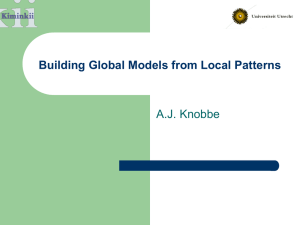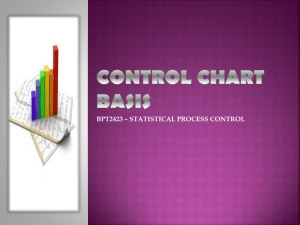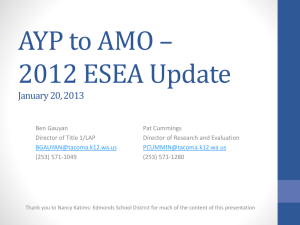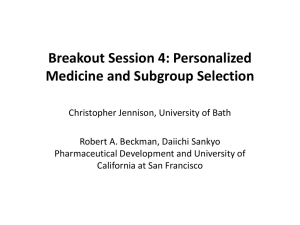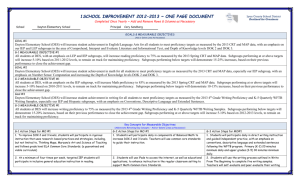on injectors, projectors and normalizers of finite groups
advertisement
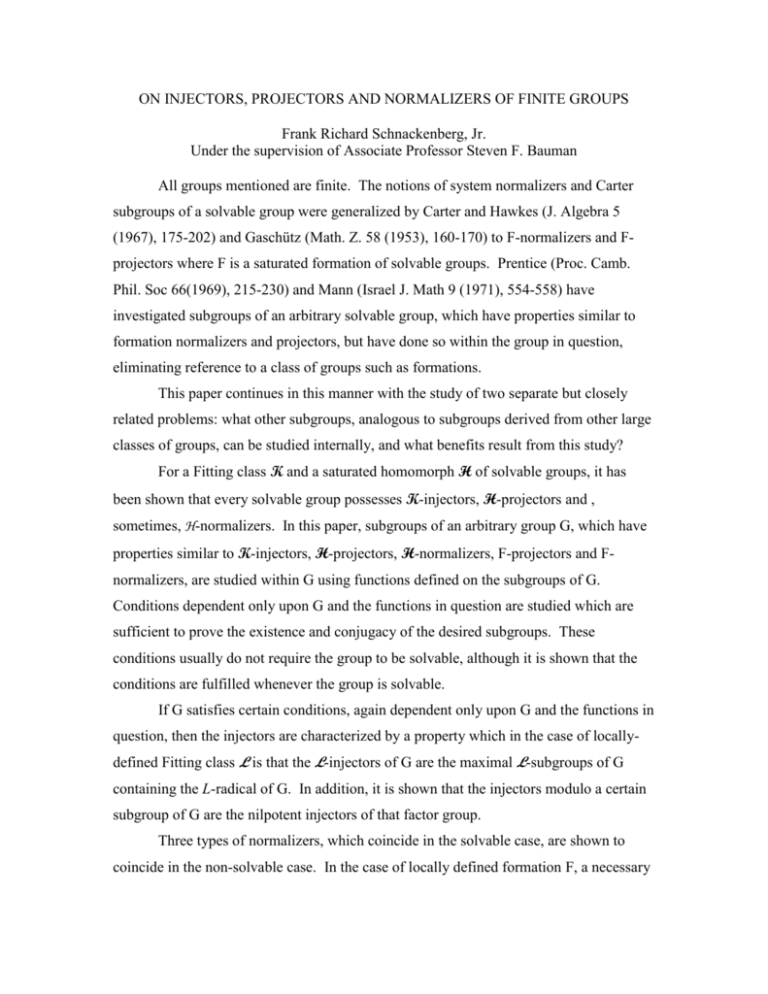
ON INJECTORS, PROJECTORS AND NORMALIZERS OF FINITE GROUPS
Frank Richard Schnackenberg, Jr.
Under the supervision of Associate Professor Steven F. Bauman
All groups mentioned are finite. The notions of system normalizers and Carter
subgroups of a solvable group were generalized by Carter and Hawkes (J. Algebra 5
(1967), 175-202) and Gaschütz (Math. Z. 58 (1953), 160-170) to F-normalizers and Fprojectors where F is a saturated formation of solvable groups. Prentice (Proc. Camb.
Phil. Soc 66(1969), 215-230) and Mann (Israel J. Math 9 (1971), 554-558) have
investigated subgroups of an arbitrary solvable group, which have properties similar to
formation normalizers and projectors, but have done so within the group in question,
eliminating reference to a class of groups such as formations.
This paper continues in this manner with the study of two separate but closely
related problems: what other subgroups, analogous to subgroups derived from other large
classes of groups, can be studied internally, and what benefits result from this study?
For a Fitting class K and a saturated homomorph H of solvable groups, it has
been shown that every solvable group possesses K-injectors, H-projectors and ,
sometimes, H-normalizers. In this paper, subgroups of an arbitrary group G, which have
properties similar to K-injectors, H-projectors, H-normalizers, F-projectors and Fnormalizers, are studied within G using functions defined on the subgroups of G.
Conditions dependent only upon G and the functions in question are studied which are
sufficient to prove the existence and conjugacy of the desired subgroups. These
conditions usually do not require the group to be solvable, although it is shown that the
conditions are fulfilled whenever the group is solvable.
If G satisfies certain conditions, again dependent only upon G and the functions in
question, then the injectors are characterized by a property which in the case of locallydefined Fitting class L is that the L-injectors of G are the maximal L-subgroups of G
containing the L-radical of G. In addition, it is shown that the injectors modulo a certain
subgroup of G are the nilpotent injectors of that factor group.
Three types of normalizers, which coincide in the solvable case, are shown to
coincide in the non-solvable case. In the case of locally defined formation F, a necessary
and sufficient condition for the existence and conjugacy of F -normalizers of G is that the
F -residual of G be solvable.
Approved
Steven Bauman (signed)
Date
September 5, 1972
ON INJECTORS, PROJECTORS AND NORMALIZERS OF FINITE GROUPS
BY
FRANK RICHARD SCHNACKENBERG, JR.
A thesis submitted in partial fulfillment of the
Requirements for the degree of
DOCTOR OF PHILOSOPHY
(Mathematics)
at the
UNIVERSITY OF WISCONSIN
1972
ACKNOWLEDGMENTS
I wish to express my sincere appreciation to Professor Steven F. Bauman for his
patience, wise counsel and advice during the research and preparation of this paper. I
also wish to thank Professor I. Martin Isaacs for his helpful suggestions in the final stages
of the preparation of this paper.
TABLE OF CONTENTS
II.
Preliminaries
1.1
Notation
The notation used is standard.
N G (N < G) means N is a (proper) subgroup of G.
N G (N G) means N is a (proper) normal subgroups of G.
N G means N is a subnormal subgroups of G.
A B (A B) means A is a (proper) subset of B.
If is a set of primes, then ’ = {p | p is prime and p }. For {p}’ = {q | q p}, we
write p’.
G is a -group means the order of G is divisible only by primes in .
G is a ’-group means the order of G is divisible only by primes not in .
S denotes the class of solvable -groups; Sp denotes the class of solvable p-groups.
S’ denotes the class of solvable ’-groups; Sp’ denotes the class of solvable p’-groups.
G denotes the class of -groups.
G’ denotes the class of ’-groups.
O(G) denotes the largest normal -subgroups of G.
Op’(G) denotes the largest normal p’-subgroups of G.
Op’,p(G) denotes the largest normal p-nilpotent subgroup of G.
O(G) denotes the smallest normal subgroup of G such that G/O(G) is a -group.
Op(G) denotes the smallest normal subgroup of G such that G/Op(G) is a p-group.
CG(H) denotes the centralizer of H in G.
NG(H) denotes the normalizer of H in G.
Z(G) denotes the center of G.
F(G) denotes the fitting subgroup of G.
(G) denotes the Frattini subgroup of G.
If A and B are classes of groups, then AB = {G | there exists N G such that N A and
G/N B.
G = A B means G is the direct product of A and B.
G = means G is the group generated by .
G = means G is the group generated by the subgroups of A and B.
{Ni | i I} = denotes the product of the groups Ni, i I.
N denotes the class of nilpotent groups.
H is a -Hall subgroup of G means H is a -group and ((G : H), p) = 1 for every p .
G satisfies E if G has at least one -hall subgroup.
G satisfies C if G satisfies E and any two -Hall subgroups of G are conjugate in G.
G satisfies D if G satisfies C and every -subgroup of G is contained in some -Hall
subgroup of G.
1.2
Introduction
Recent work of Prentice [25] and Mann [23] has suggested an internal approach
to certain problems that heretofore have involved global considerations. It is the purpose
of this paper to continue the investigation of these problems in the same manner.
All groups considered are assumed to be finite.
Fischer introduced the notion of a Fitting class of groups (see [18]); that is, an
isomorphism closed class F of groups such that if G F and N G, then N F, and if Ni
F and Ni G for i = 1, 2, then N1N2 F. From this definition it is clear that every
group G has, for every such F, a unique normal subgroup that is maximal with respect to
belonging to F. This subgroup is called the F-radical and is denoted by GF. If F is any
Fitting class, then an F-injector of a group G is a subgroup V of G such that V ∩ N is a
maximal F-subgroup of N {i.e., V ∩ N F and V ∩ N = L whenever V ∩ N L N and
L F) for every subnormal subgroup N of G. In [8] it was shown that every solvable
group possesses a unique conjugacy class of F-injectors for every Fitting class F of
solvable groups.
Hartley in [18] introduces the notion of a locally defined Fitting class F; that is, F
= where, for each prime p, F(p) is a Fitting class. This, of course, may easily be
considered to be a kind of dual of a locally defined formation X; that is , where, for each
prime p, X(p) is a formation. A formation is an isomorphism closed class Y of groups
such that if G Y and N G, the G/N Y, and if G/Ni Y for i = 1,2, then G/N1 ∩ N2
Y.
On a more basic level, formations and Fitting classes may be considered duals of
each other. The normal subgroup closure property of Fitting classes may be thought of as
a dual notion of the homormorphic image closure property of formations. Likewise, the
normal product closure property of Fitting classes may be thought of as a dual notion of
the subdirect product closure property of formations.
The properties of a Fitting class motivate the definition of a type of function, for
each prime p, from the set of subgroups of a fixed but arbitrary group G to that set again.
The set of the subgroups in the images of the functions satisfies properties similar to
those of a Fitting class. These subgroups are then used to define a set of subgroups of G
that is analogous to the set of subgroups of G contained in a locally defined Fitting class.
It is then shown that if, for certain normal subgroups in the images of the functions, G
modulo each of those normal subgroups meets certain requirements generally less
restrictive than the solvability of G, then G possesses a unique conjugacy class of
subgroups, analogous to a conjugacy class of F-injectors for some Fitting class F, and
possessing similar properties.
The requirements which the factor groups mentioned above must possess are
closely related to one used by Mann [24] in extending the class of groups which have a
unique conjugacy class of nilpotent injectors beyond solvable groups. One of the results
of this paper is that the injector-like subgroups arising from the functions discussed
earlier are completely determined by the nilpotent injectors of a certain factor group of
G. It is also demonstrated that while every locally defined Fitting class may be
interpreted as a set of appropriate functions, the converse does not hold.
Chapter III extends the internal approach to the results on homomorphs. A
homomorph is an isomorphism closed class H of groups such that every homomorphic
image of a group in H lies again in H. A homomorph H is said to be primitively closed
if G H whenever G/coreG(M) H for every maximal subgroup M of G. A subgroup S
of G is said to be an H-projector of G is S H and L = SL0 whenever S L G, L0 L
and L/L0 H. (The definition is the same when H is a formation.) Schunck [26]
defines a homomorph of solvable groups to be saturated if every solvable group has an
H-projector. Theorem 4.4 of [26] shows that a homomorph H of a solvable group is
saturated if and only if it is primitively closed.
The relationship between H-projectors and primitive closure is exploited in the
definition of a type of function that ultimately yields the desired results. Given a fixed
but arbitrary group G, this type of function maps ordered pairs, each consisting of a
subgroup of G and a conjugacy class of maximal subgroups of that subgroup, to
subgroups of G. The set of image subgroups possesses properties similar to a
homomorph. Again the image subgroups are used to define a set of subquotients of G
analogous to the set of subquotients of G lying in some primitively closed homomorph.
If the group G satisfies certain conditions, dependent upon the function and generally less
restrictive than solvability, then G is shown to possess a unique conjugacy class of
subgroups with properties similar to those of an H-projector for some primitively closed
homomorph F.
As a duel of an F-radical, one sees from the definition of a formation X that for
every group G there exists a unique normal subgroup N of G such that G/N is the largest
factor group of G lying in X. That subgroup is called the X-residual of G and is denoted
by GX. For a locally defined formation, , Carter and Hawkes [2] investigated a
generalization of system normalizers, namely X-normalizers. An X-normalizer of a
solvable group G is a subgroup D of G of the form . These subgroups were shown to
have properties similar to those of system normalizers: they form a unique conjugacy
class; for each prime p, they cover the p-chief factors of G centralized by and avoid the
p-chief factors of G not centralized by ; and they are characterized as minimal members
of certain chains of subgroups of G.
Mann shows in [23] that there exists a solvable group G and primitively closed
homomorph H such that G H but G has no subgroups of the type that characterize
formation normalizers. Mann thus defines homomorph normalizers as minimal members
of certain chains of subgroups, similar to the characterization of formation normalizers;
and then restricts the class of groups under consideration to those satisfying the
appropriate condition regarding the existence of the necessary subgroups. We adopt this
approach in Chapter III and prove the usual results regarding normalizers using
conditions less stringent than solvability.
For a fixed but arbitrary solvable group G, Prentice [25] and Mann [23] have
defined separate types of functions from the set of subgroups of G into the same set. In
each case they defined a set of subquotients of G analogous to the set of subquotients of
G contained in some locally defined formation. They then proved the existence of
subgroups in the respective sets of subquotients of G with properties similar to those of
either formation projectors or normalizers.
Restricting the discussion in Chapter IV to the type of functions defined by Mann,
we show that each such function induces a function of the type considered in Chapter III
in a natural way. We are then able to use the results of Chapter III to prove the usual
results regarding projectors and normalizers as defined by the functions considered in
Chapter IV, again relaxing the condition of solvability.
We note that the normalizers considered in Chapter III are defined as minimal
members of certain chains of subgroups. In addition to this method of definition of
formation normalizers and the one mentioned earlier, Fischer [7] defined formation
normalizers as the formation projectors of certain subgroups of G. in the solvable case,
these three methods of definition yield the same conjugacy class of subgroups. In
Chapter IV we investigate the subgroups arising from each of these definitions and their
relationship to the others in the nonsolvable case.
The underlying emphasis of this paper is a return to an internal approach to
questions heretofore given global consideration. In classical formation theory or Fitting
class theory, the typical theorem schema is: “If F is a formation of solvable groups, then
every solvable group…”, or “If F is a Fitting class of solvable groups, then every solvable
group…”. By eliminating the large class of groups, we are able to consider the classical
questions on a group-by-group basis with the theorems bearing the typical schema: “If G
is a group, X a certain set of functions from the set of subgroups of G into the same set,
and G satisfies certain conditions dependent only upon X, then…”
II.
Normal Intersection Conjugacy Functions
Hartley in [18] introduces the notion of a locally defined Fitting class of solvable
groups; that is, a Fitting class of the form where F(p) is a Fitting class of solvable groups
for each prime p. As mentioned in the introduction, this seems a natural way to dualize
the concept of a locally defined formation of solvable groups; that is, a formation which
may always be written in the form where H(p) is a formation of solvable groups for each
prime p.
In this chapter we investigate conjugacy classes of subgroups of a fixed but
arbitrary group where the definition of these subgroups is made entirely within the
structure of the group. These subgroups are analogous to F-injectors of the group where
F is a locally defined Fitting class, but preclude the existence of such a class in their
definition. The subgroups used to define the subgroups of such a conjugacy class are
analogous to the F(p)-radicals of the group, but again obviate the need for such Fitting
classes.
These defining subgroups are then used to characterize the injector-like subgroups
as subgroups that are maximal with respect to a certain property. In the case of
F-injectors of a solvable group, where F is a locally defined Fitting class, this property is
“maximal with respect to being an F-subgroup containing the F-radical.” This property is
shown to be equivalent to being a maximal nilpotent subgroup of a certain factor group
containing the Fitting subgroup of that factor group. Mann ahs shown in [24] that this
property characterizes nilpotent injectors; thus these subgroups, modulo a certain normal
subgroup of the group, are precisely the nilpotent injectors of that factor group.
The defining subgroups are also used to find conditions on the group, usually less
restrictive than solvability, for which the usual results remain valid. The conditions are
closely related to nilpotent constraint (i.e., CG(F(G)) F(G)) which was used by Mann
[24] in the characterization of nilpotent injectors mentioned above.
The subgroups used in the definition of the subgroups of the conjugacy classes
will be the images of certain functions which in a sense select the F(p)-radicals of the
subgroups. Indeed, any Fitting class F induces this type of function by mapping each
subgroup to its F-radical. However, example 2.4.b demonstrates the existence of such
functions which do not arise in this way from any Fitting class. Thus the type of
functions defined below may be thought of as a generalization of the radical in the
classical theory.
Definition 2.1. Let G be a group. A normal intersection conjugacy functions of G
(NICF of G) is a function Y from {H | H G } into itself satisfying the following
conditions:
1.
for every H G, Y(H) H;
2.
for every H G and g G, ;
3.
if K H G, then Y(K) = Y(H) K.
(We note that condition 2 and Y(H) H imply Y(H) H.)
Definition 2.2. Let G be a group. A normal intersection conjugacy function system of G
is a collection {Yp} of NICF’s of G, one for each prime p.
Definition 2.3. Let Y = {Yp} be an NICF system of a group G. Then define Y(G) =
{Yp(H) | Yp Y and H G } and call Y(G) the image of Y in G.
Example 2.4.
Given a group G, we define an NICF, Yp, of G for each prime p by Yp(H)
= Op’ , p(H) for each H G. Then is clearly an NICF system of G.
b) Let K be a noncyclic group of order 4. Let and define Y by and . Then Y is
an NICF of K, but for every H K, Y(H) is not the F-radical where F is a
Fitting class since G F whenever .
Definition 2.5. Let Y be an NICF system of a group G. Then define . Call the Y-set of
G.
Remark 2.6.
If is a locally-defined Fitting class of solvable groups, then for a solvable
group G, {H | H G and H F } = {H | H G and for each p, H/HF(p) Sp’ Sp } = {H |
H G and for each p, H/HF(p) is p-nilpotent}. Thus is meant to correspond to the set of
subgroups of G contained in a locally defined Fitting class.
Every locally defined Fitting class gives rise in a natural way to an NICF system
of a group G. For each prime p, define a function Yp by where H is a subgroup of G and
is the H(p)-radical of H. Then it is easy to see that Y = {Yp} is an NICF system of G
and for a subgroup H of G, H H if and only if H .
However, there is a group G and NICF system Y of G such that there is no Fitting
class F such that for H G, if and only if H F. The following example also shows that
may not be isomorphism closed.
Example 2.7.
Let , the direct product of two copies of the symmetric group on three
elements. We define an NICF system of G in the following way:
Y = {Yp | Yp(G) = G for p 3 and Y3(G) = 3 , and for H G, Yp(H) = Yp(G)
H}.
Then and since
*
is not 3-nilpotent, . However, Y3(3) = 3 and Y2(3) = 3 , and so .
Thus is not isomorphism closed, and hence there is no Fitting class F such that
H | H G and H F Y G .
We now show that for a give NICF system Y of G, has certain properties in
common with Fitting classes.
Theorem 2.8. Let Y be an NICF system of G. Then the following hold.
1)
If N < H G and H Y G , then N Y G .
2)
If Ni < H G and Ni Y G for i = 1, 2, then N1N2 Y G .
Proof. 1) If H Y G , then for each prime p and Yp Y, H/Yp(H) is p-nilpotent.
Since
NYp H
N
N
, we have for each p, N/Yp(N) is p-nilpotent and
Yp N Yp H I N
Yp H
so N Y G .
2).
If Ni Y G for i = 1, 2, then for each p and Yp Y,
Ni
is pYp Ni
nilpotent. Since Ni < N1N2 , Yp N1N2 Ni Yp Ni , i 1, 2 . Thus
2 NY N N
N Y N N
Ni
N1N2
i p 1 2 is p-nilpotent and so
i p 1 2 is
Yp N1N 2 Ni
Yp N1N 2
Yp N1N2 i 1 Yp N1N2
p-nilpotent. Thus N1N2 Y G .
Q.E.D.
Definition 2.9. Let Y be an NICF system of a group G. For each subgroup H of G define
H Y N | N < H and N Y G and call HY the Y-radical of H. (We note that
HY Y G by theorem 2.8.)
Theorem 2.10. Let Y be an NICF system of G.
1)
2)
If H < G , then for each Yp Y, Yp H < G .
For every subgroup H of G and Yp Y, Yq Y, we have Yq(Yp(H)) =
Yp(Yq(H)) = Yp(H) Yq(H). In particular, Yp(Yp(H)) = Yp(H).
H
3)
For every subgroup H of G and g G, HY
4)
For K < H G, K Y H Y I K .
Proof. 1)
2)
g
g
Y
.
For every g G and Yp Y, Yp H Yp Hg Yp H .
g
Since Yp H < H , we have Yq Yp H Yq H I Yp H . Similarly,
Yq H < H implies Yp Yq H Yp H I Yq H .
H
Y H
g
3)
Since HY/Yp(HY) is p-nilpotent,
Y
is p-nilpotent and so
g
Y
p
H is p-nilpotent. Thus H < H and H
Y H
H H . By the same argument we have
g
Y
g
g
g
Y
g
Y
Y G and so
Y
p
g
g
Y
Y
H g
Y
g 1
1
H H
g
g
Y
g
Hg H Y . Thus Hg HY
Y
Y
Y
as desired.
g
and therefore
4)
Since HY I K < HY , HY I K Y G and so H Y I K K Y . By 3)
K
above, for every h H, K Y
h
h
Y
K Y . Thus K is normal in H and
so K Y H Y I K . Therefore K Y H Y I K .
Q.E.D.
Next --->
